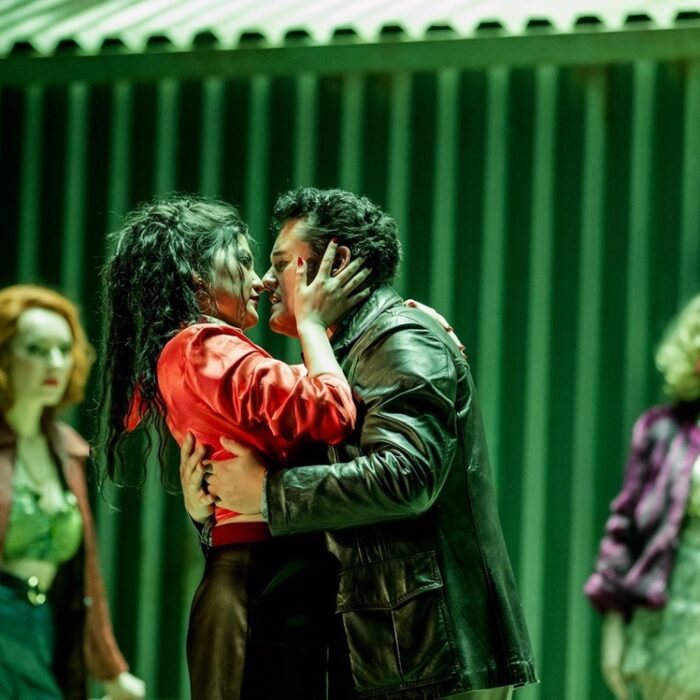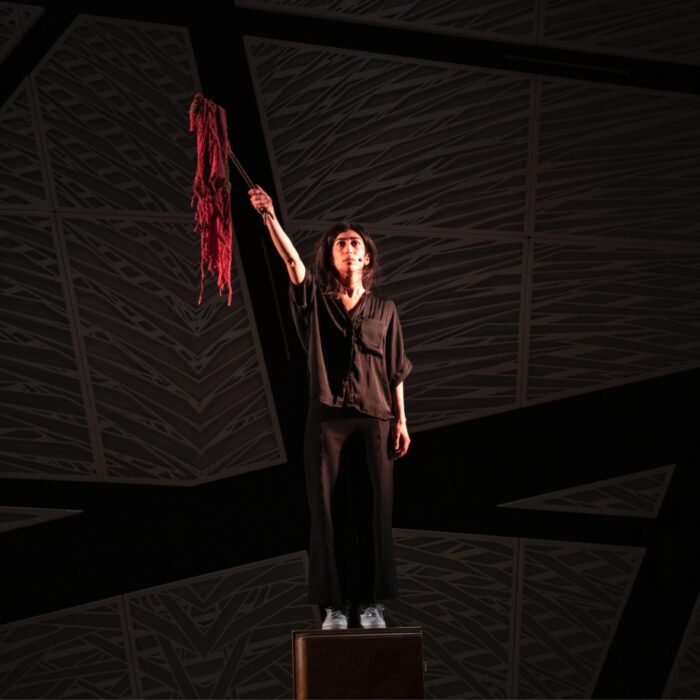
Reggio Emilia Teatro Municipale Valli 2021-22 Review: Aufstieg Und Fall Der Stadt Mahagonny
Brockhaus & Franklin Bring Mahagonny Thrillingly to Life
By Alan Neilson(Photo: Teatro Municipale Valli)
Weill and Brecht had major disagreements over the meaning and location of their opera “Aufstieg und Fall Der Stadt Mahagonny.” While Brecht saw it as a criticism of the evils of capitalism, for Weill, it was more an exploration of human greed, which for many people, with only a superficial understanding of the word capitalism, amounts to the same thing. Both interpretations, along with open-ended readings, provide the director with a high degree of interpretative freedom on how to proceed.
The location of the drama is slightly more difficult. At the point in Brecht’s life in which he wrote the libretto, he held a naïve, almost comic book idea of the USA, viewing it as a capitalist dream, a place of outlaws beyond the reach of justice, of wild frontiers, an ideal place for Begbick, Trinity Moses, and Fatty to establish their city, while for Weill it could be a city anywhere, it really did not matter. Greed is found everywhere. However, today, regardless of Weill or Brecht’s opinions on the matter, we tend to associate the works on which they collaborated as being inextricably linked with Germany’s Weimar Republic and, more specifically, with Berlin. Ironically, this is partly a result of the widespread success of Kander and Ebb’s musical “Cabaret” and its later film adaptation, themselves clearly inspired in part by Weill and Brecht’s collaboration. A production of “Aufstieg und Fall Der Stadt Mahagonny,” which completely ignored the ambiance of the cabaret that one associates with 1920-30s Berlin, would just not feel right.
For this production at the Teatro Municipale Valli, Reggio Emilia, the director Henning Brockhaus favored a Brechtian interpretation playing up the miseries of capitalism by having its losers, the underclass, populating the stage, hidden in the shadowy background and enduring a beating from the successful, whose motivation was simply that they could do anything they wanted. He also used video to highlight how a hurricane in such a system can lead to manmade economic destructive consequences. Yet, he still incorporated Man’s greed in all its glory, with the scene in which Jack eats himself to death particularly revolting. The two threads complemented each other well, as the greed and the economic system reinforced and fed off each other. While Brockhaus kept to a location that certainly could have been the USA in the early decades of the 20th century, he was careful to include the atmosphere of the cabaret and the decadence of the Weimar Republic.
Excellent Team Produce A First-Rate Staging
And with the aid of scenographer Margherita Palli, costume designer Giancarlo Colis, lighting designer Pasquale Mari, video designer Marco Spinaci, and choreographer Valentina Escobar, it all came together brilliantly.
Right from the beginning, the production raced along as the three fugitives on a motorbike and sidecar crashed through a front of a stage screen showing a black and white video of cars racing through a city. Palli’s set was simple yet adaptable and highly effective, consisting of a wooden structure that divided the stage into two levels, with a walkway wrapped around the orchestra pit. She also made use of a side box which was turned into a stall selling whiskey. There was plenty of space in the central area of the stage in order to allow for the oft crowded scenes, as well as for the many stunning dance routines. Props were wheeled on and off with ease, and because of the constant movement of the actors, and the brilliance with which Brockhaus ensured the audience was constantly engrossed in the drama, they were hardly noticeable.
Although the sets were almost uniformly dark in color, Mari’s well-focused lighting and Colis’ stunning costumes meant that the stage was constantly awash with color, which created a vibrant and exciting visual impact. Moreover, the costumes were so imaginatively and intelligently designed that they often focused the attention on the characters as soon as they walked onto the stage, in such a way that the audience was immediately aware of their role. Particularly noticeable were Begbick’s flamboyant dresses, garishly ornate glasses, and big blond hair, which helped clearly define her as the madam, the boss, the woman in control. Jenny, with her short skirts, fishnet stockings, and shocking pink hair, was a convincingly seductive prostitute, while having the Alaskan lumberjacks attired in flowery shirts with straw hats as if they were on a Caribbean island was an amusing touch that captured the mentality of men on holiday after a bit of fun. The scantily clad dancing girls with their array of loudly colored wigs and black hats a là Sally Bowles from “Cabaret” immediately conjured up images of 1920-30s Berlin.
Escobar’s choreography was equally compelling. The dance routines sparkled, and the crowd scenes were expertly managed. All of which added to the overall energy and vitality while playing their part in ensuring that the dramatic thrust of the production never lapsed.
Franklin Elicits A Strong Performance From The Orchestra
The Orchestra dell’Emilla-Romagna Arturo Toscanini, under the baton of Christopher Franklin, produced a thrilling performance in which he not only captured the opera’s dramatic twists and turns but also the ambiance of the nightclub scene of the Weimar Republic, in which he successfully combined the flavor of cabaret with art music, whilst never degenerating into parody, nor allowing the performance to become too rarified and exalted. He was also successful in developing the work’s wonderful textures and was particularly attentive to the constant shifts in the musical pace and dynamics, which gave the performance an energetic bite that helped highlight the underlying tensions. The dance numbers were performed with a raw vitality which allowed the music to fizz and sparkle, which both aided and reflected the superb dance routines.
A Commanding Performance From Kolosova
Such was the overall quality of the singing that naming an outstanding singer does not quite feel right; however, such was the performance of mezzo-soprano Alisa Kolosova in the role of Leokadja Begbick that it would be remiss not to single her out. In what was a role-dominating performance, Kolosova sang and acted with such skill and confidence that she commanded the stage with her larger-than-life portrayal, and her depiction of the judge in the final act was superb. Listening to her sing, one could not help but be impressed by her vocal strength and security. There was never any sense of anxiety or the need to force the voice, and her ability in using it to shape her character, with the use of coloring, intonation, and emotional accents, was excellent. Hers was a Begbick that exuded control, allowing her to dictate to those around her with ease.
Soprano Nadja Mchantaf looked and acted out the part of the prostitute Jenny convincingly, coming across as suitably worldly-wise and hard-headed. Singing with just the right tone and inhabiting a space between classical and a looser style, she successfully conjured up the sound of a 1920s Berlin nightclub singer. She moved the voice well, crafting intelligently controlled, seductive phrases, and displayed a pleasing, strong upper register. Her rendition of the famous “Alabama Song” was strongly delivered, and successfully established her motivations and outlook on life. Mchantaf was by turn alluringly seductive as in Act one, scene six, and brutally hard as in Act two, scene 19, when she says her farewell to the soon to be executed Jimmy, in which she convincingly remained emotionally detached while mouthing empty pleasantries, which made it a painful scene to watch.
The demanding role of Jimmy Mahoney was played by tenor Tobias Häckler. Although his singing impressed, his presentation was, on occasions, that of a too decent upright fellow, and who, therefore, seemed out of place in a brothel or urging people to do whatever they please, but which on the positive side made his fate all the more poignant. He has a strong, agile voice, which he projected well, moving easily above the chorus and orchestra, and which he used successfully to develop his character, with only the occasional noticeable blemish. His Act three aria “Wenn der Himmel hell wird,” in which he reflects upon his position and gives voice to his feelings about his forthcoming execution, was particularly pleasing, for which he supplied an emotional and lyrical rendition, showing off his intelligent phrasing, pleasing timbre and attention to detail to good effect.
A Strong Supporting Cast
Tenor Chris Merritt can be forgiven the occasional squally emission, for his performance as Fatty was excellent, whom he played with a high degree of irony. Watching knowingly and calmly at the goings-on, he rarely reacted strongly, having obviously seen it all before. Vocally powerful, he was able to push his voice with meaning and with ease.
Trinity Moses was played by bass-baritone Zoltan Nagy, whose slick, cool demeanor was reflected in his singing, which displayed a clear, pleasing tone with agility and the ability to mold phrases to develop his character. His vicious killing of Jack in the boxing ring would have surprised no one.
Tenor Christopher Lemmings was cast in the roles of Jack, who creates a great spectacle as he eats himself to death, much to the admiration of all the onlookers, and Tobby Higgins, who escapes the charge of murder by bribing the court. Lemming’s performances were well-defined; his singing was articulate, clear with a pleasing tone.
Jimmy’s friends Bill and Joe were essayed by bass-baritone Horst Lamnek and bass Jerzy Butrin, respectively. Both sang well and produced strong performances.
In what was certainly a case of luxury casting, the six girls accompanying Jenny, comprising Roxana Herrera, Elizabeth Hertzberg, Yulia Tkachenko, Cecilia Bernini, Kamelia Kader, and Mariangela Marini, created a marvelous impression. Not only were they wonderfully costumed, but sang with great skill and energy.
Filippo Lanzi did a fine job in the spoken role of the narrator, who introduced each scene.
Overall, this was an excellent presentation that zipped along, brilliantly capturing the degeneracy, corruption, and attractions of Mahagonny. Brockhaus’ staging had color, movement, drama, and dancing. It was imaginative and coherent, with a clear underlying vision. It conjured up ideas of Berlin cabaret in the Weimar Republic, but as an idea only, not as a physical location. Musically, Franklin ensured it was on the same high level, with the orchestra moving seamlessly between the idioms of song and its more recognizably classical forms, while the performance of the singers was uniformly high.
It was a co-production with Parma’s Teatro Regio.



